The AMD Radeon R9 290X Review
by Ryan Smith on October 24, 2013 12:01 AM EST- Posted in
- GPUs
- AMD
- Radeon
- Hawaii
- Radeon 200
XDMA: Improving Crossfire
Over the past year or so a lot of noise has been made over AMD’s Crossfire scaling capabilities, and for good reason. With the evolution of frame capture tools such as FCAT it finally became possible to easily and objectively measure frame delivery patterns. The results of course weren’t pretty for AMD, showcasing that Crossfire may have been generating plenty of frames, but in most cases it was doing a very poor job of delivering them.
AMD for their part doubled down on the situation and began rolling out improvements in a plan that would see Crossfire improved in multiple phases. Phase 1, deployed in August, saw a revised Crossfire frame pacing scheme implemented for single monitor resolutions (2560x1600 and below) which generally resolved AMD’s frame pacing in those scenarios. Phase 2, which is scheduled for next month, will address multi-monitor and high resolution scaling, which faces a different set of problems and requires a different set of fixes than what went into phase 1.
The fact that there’s even a phase 2 brings us to our next topic of discussion, which is a new hardware DMA engine in GCN 1.1 parts called XDMA. Being first utilized on Hawaii, XDMA is the final solution to AMD’s frame pacing woes, and in doing so it is redefining how Crossfire is implemented on 290X and future cards. Specifically, AMD is forgoing the Crossfire Bridge Interconnect (CFBI) entirely and moving all inter-GPU communication over the PCIe bus, with XDMA being the hardware engine that makes this both practical and efficient.
But before we get too far ahead of ourselves, it would be best to put the current Crossfire situation in context before discussing how XDMA deviates from it.

In AMD’s current CFBI implementation, which itself dates back to the X1900 generation, a CFBI link directly connects two GPUs and has 900MB/sec of bandwidth. In this setup the purpose of the CFBI link is to transfer completed frames to the master GPU for display purposes, and to so in a direct GPU-to-GPU manner to complete the job as quickly and efficiently as possible.
For single monitor configurations and today’s common resolutions the CFBI excels at its task. AMD’s software frame pacing algorithms aside, the CFBI has enough bandwidth to pass around complete 2560x1600 frames at over 60Hz, allowing the CFBI to handle the scenarios laid out in AMD’s phase 1 frame pacing fix.
The issue with the CFBI is that while it’s an efficient GPU-to-GPU link, it hasn’t been updated to keep up with the greater bandwidth demands generated by Eyefinity, and more recently 4K monitors. For a 3x1080p setup frames are now just shy of 20MB/each, and for a 4K setup frames are larger still at almost 24MB/each. With frames this large CFBI doesn’t have enough bandwidth to transfer them at high framerates – realistically you’d top out at 30Hz or so for 4K – requiring that AMD go over the PCIe bus for their existing cards.
Going over the PCIe bus is not in and of itself inherently a problem, but pre-GCN 1.1 hardware lacks any specialized hardware to help with the task. Without an efficient way to move frames, and specifically a way to DMA transfer frames directly between the cards without involving CPU time, AMD has to resort to much uglier methods of moving frames between the cards, which are in part responsible for the poor frame pacing we see today on Eyefinity/4K setups.
CFBI Crossfire At 4K: Still Dropping Frames
For GCN 1.1 and Hawaii in particular, AMD has chosen to solve this problem by continuing to use the PCIe bus, but by doing so with hardware dedicated to the task. Dubbed the XDMA engine, the purpose of this hardware is to allow CPU-free DMA based frame transfers between the GPUs, thereby allowing AMD to transfer frames over the PCIe bus without the ugliness and performance costs of doing so on pre-GCN 1.1 cards.
With that in mind, the specific role of the XDMA engine is relatively simple. Located within the display controller block (the final destination for all completed frames) the XDMA engine allows the display controllers within each Hawaii GPU to directly talk to each other and their associated memory ranges, bypassing the CPU and large chunks of the GPU entirely. Within that context the purpose of the XDMA engine is to be a dedicated DMA engine for the display controllers and nothing more. Frame transfers and frame presentations are still directed by the display controllers as before – which in turn are directed by the algorithms loaded up by AMD’s drivers – so the XDMA engine is not strictly speaking a standalone device, nor is it a hardware frame pacing device (which is something of a misnomer anyhow). Meanwhile this setup also allows AMD to implement their existing Crossfire frame pacing algorithms on the new hardware rather than starting from scratch, and of course to continue iterating on those algorithms as time goes on.
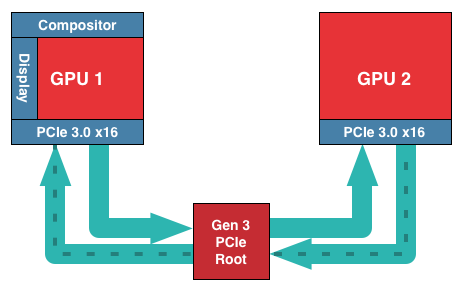
Of course by relying solely on the PCIe bus to transfer frames there are tradeoffs to be made, both for the better and for the worse. The benefits are of course the vast increase in memory bandwidth (PCIe 3.0 x16 has 16GB/sec available versus .9GB/sec for CFBI) not to mention allowing Crossfire to be implemented without those pesky Crossfire bridges. The downside to relying on the PCIe bus is that it’s not a dedicated, point-to-point connection between GPUs, and for that reason there will bandwidth contention, and the latency for using the PCIe bus will be higher than the CFBI. How much worse depends on the configuration; PCIe bridge chips for example can both improve and worsen latency depending on where in the chain the bridges and the GPUs are located, not to mention the generation and width of the PCIe link. But, as AMD tells us, any latency can be overcome by measuring it and thereby planning frame transfers around it to take the impact of latency into account.
Ultimately AMD’s goal with the XDMA engine is to make PCIe based Crossfire just as efficient, performant, and compatible as CFBI based Crossfire, and despite the initial concerns we had over the use of the PCIe bus, based on our test results AMD appears to have delivered on their promises.
The XDMA engine alone can’t eliminate the variation in frame times, but in its first implementation it’s already as good as CFBI in single monitor setups, and being free of the Eyefinity/4K frame pacing issues that still plague CFBI, is nothing short of a massive improvement over CFBI in those scenarios. True to their promises, AMD has delivered a PCie based Crossfire implementation that incurs no performance penalty versus CFBI, and on the whole fully and sufficiently resolves AMD’s outstanding frame pacing issues. The downside of course is that XDMA won’t help the 280X or other pre-GCN 1.1 cards, but at the very least going forward AMD finally has demonstrated that they have frame pacing fully under control.
On a side note, looking at our results it’s interesting to see that despite the general reuse of frame pacing algorithms, the XDMA Crossfire implementation doesn’t exhibit any of the distinct frame time plateaus that the CFBI implementation does. The plateaus were more an interesting artifact than a problem, but it does mean that AMD’s XDMA Crossfire implementation is much more “organic” like NVIDIA’s, rather than strictly enforcing a minimum frame time as appeared to be the case with CFBI.


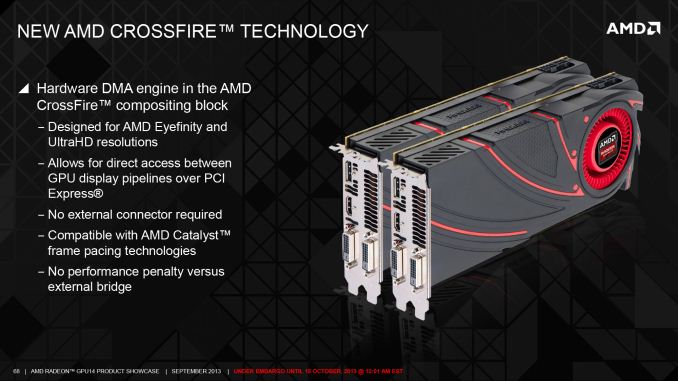
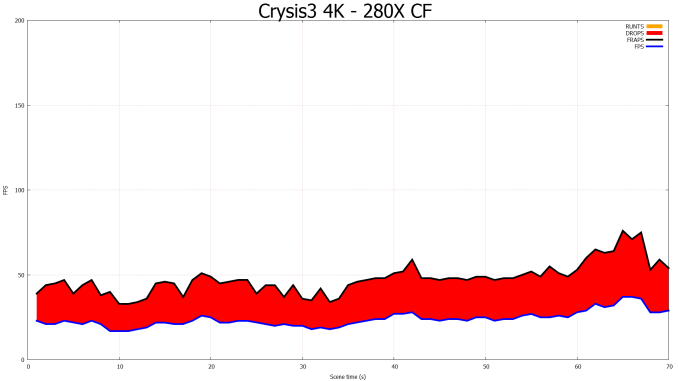
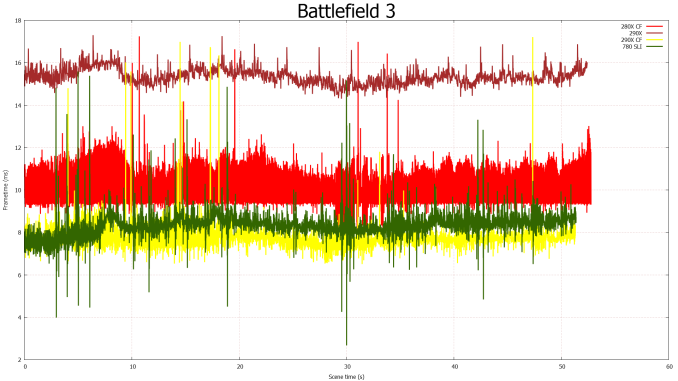
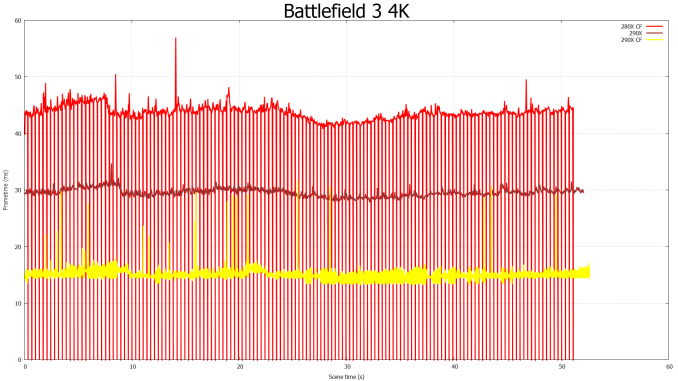








396 Comments
View All Comments
Ryan Smith - Friday, October 25, 2013 - link
Patch 3, which was the patch released right before the 280X, settled the major GPU problems. I can't speak for the turn sequences, which are still CPU bottlenecked, but as far as GPU reviews go it's good for use.TheJian - Friday, October 25, 2013 - link
Total War Rome2 has had at least 4 patches with the 4th on 10/13. Might be a 5th by now.v1.4 = v1.4.0 = v1.00.7573 = #7573.461942 last one
But site shows:
https://help.sega.com/entries/22535104-Total-War-R...
So new on 18th says post date. 5 patches to date.
Arbie - Thursday, October 24, 2013 - link
Thanks for the Crysis Warhead benchmark. The game still leads in some ways and I still enjoy playing it. But more relevant here is that we can see the progression of GPU power over a long time span. Given the slower pace of PC graphics now, some of us haven't replaced our cards in quite a while. With this benchmark I can compare apples-to-apples with anything I own.
The 290X looks great fundamentally, but 93 deg C at full load is too hot and will lead to a short card lifetime. This will probably be addressed by vendor cooling designs, and I'd wait for that.
polaco - Thursday, October 24, 2013 - link
this remmembers me the ATI4850. from factory settings it reached almost 100%. I tuned the bios to adjust the fan throttling hysteresis and max rpms or something like that, that turned my card to 80°C. So I wouldn't be surprised if just tunning this card settings a bit will take you lower temps, powertune allows for much cool things that wasn't available at the 4850 moment. Vendor cooling solutions probably do better as you stated. :)TheJian - Friday, October 25, 2013 - link
Warhead is played by ZERO people on servers. How do you play alone? Servers I checked were empty ages ago and still just a month ago. They need to be using the games with the most users active, or highest sales (which might include games we can't tell active users if they're not server based like single player etc). Warhead is played by nobody, so it shows nothing. It's the same as firing up Doom 1. Nobody cares.NeonFlak - Thursday, October 24, 2013 - link
So the review is released but unfinished? I'm getting work in progress for a couple pages.WeaselITB - Thursday, October 24, 2013 - link
This is a really poor showing on AnandTech's part. I don't come to AT because of the speed that your reviews are posted, I come because of the quality and depth of the commentary that makes up the reviews. Charts are meaningless without the commentary surrounding them.Please, in the future, throw up a one-page benchmark chart with a paragraph stating "preliminary results" or something, and come back with an actual full-fledged review. This "[work in progress]" crap is just that -- crap -- especially now that I'm reading this at 10:20am Central and still seeing a half-article. I know you guys are capable of better.
lamovnik - Thursday, October 24, 2013 - link
Here is 290x fan noise test http://www.youtube.com/watch?v=T5MbOGoEMDYNotmyusualid - Thursday, October 24, 2013 - link
P1SSED MYSELF laughing!And I only came by to smile at the fan boi-ish comments.
Well done.
Kutark - Thursday, October 24, 2013 - link
Honestly, no. The fanboism is rampant in these comments. And i don't know what they're smoking about it being faster than a titan, in most cases its barely equaling and usually slightly slower. Now, is that impressive for a card thats $600? Yes, absolutely. Am i impressed? No, not in the slightest. Titan was released in FEBRUARY. That was 8 months ago. And though i am pissed at nvidia for making it so expensive, and subsequently the 780/770's so expensive. The ONLY reason they were able to pull that kind of crap is because AMD was nowhere to be found. AMD literally couldn't compete until almost a year later? I'm sorry im just not impressed. I am glad they're finally stepping up their game, because one company having no real competition is never a good thing for the consumer.